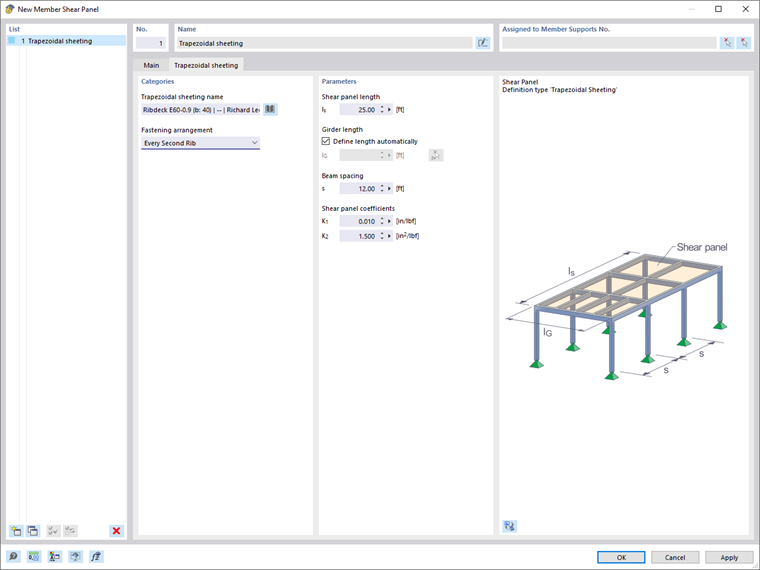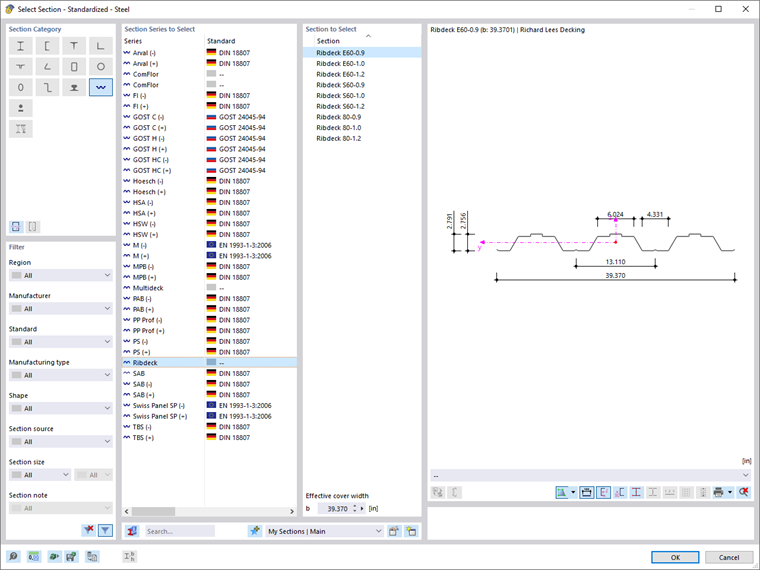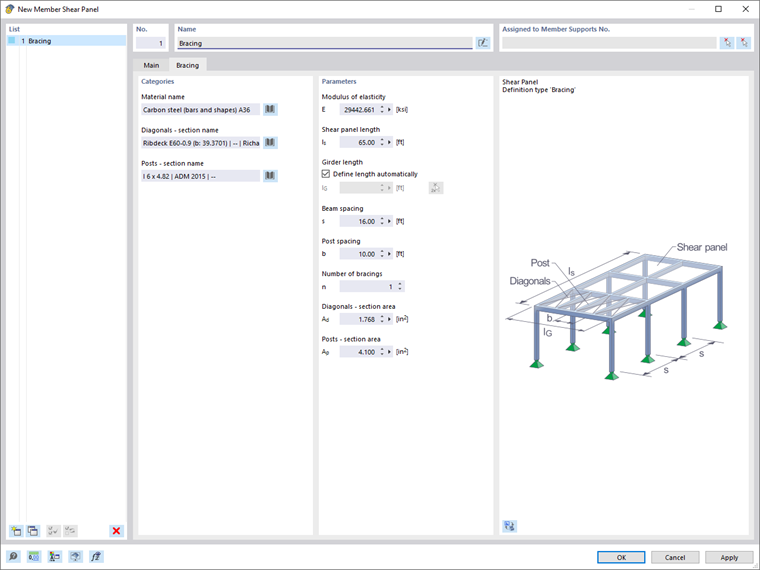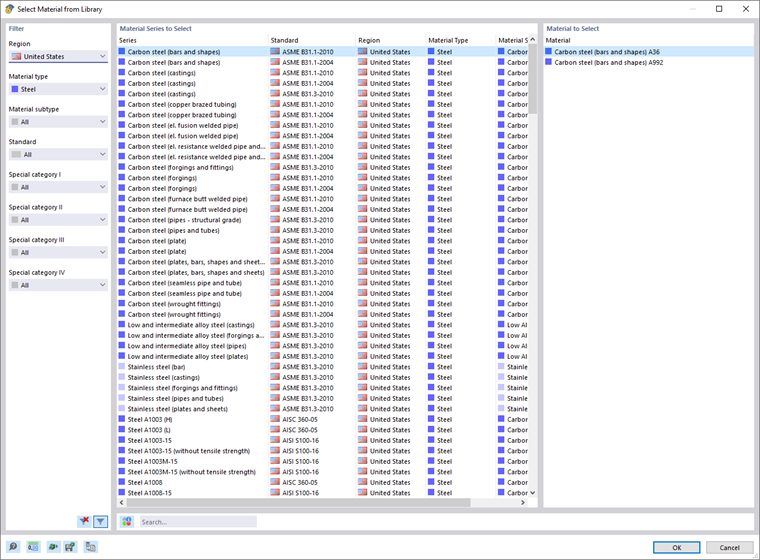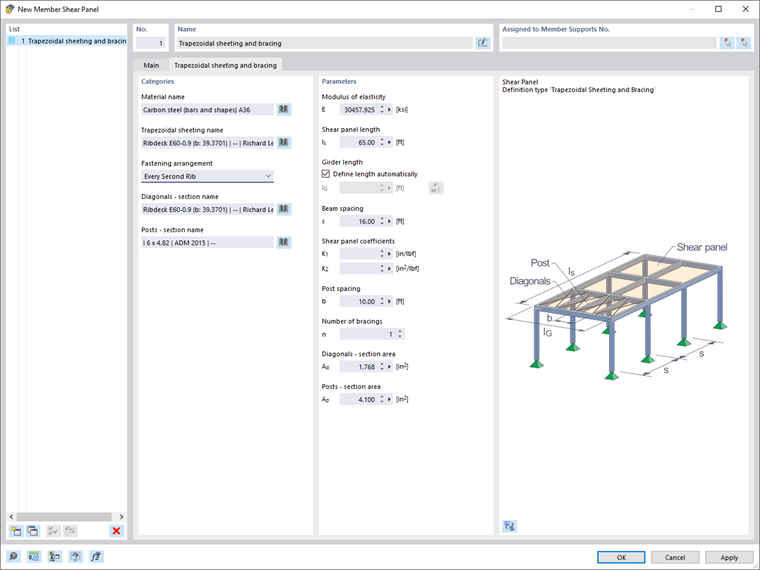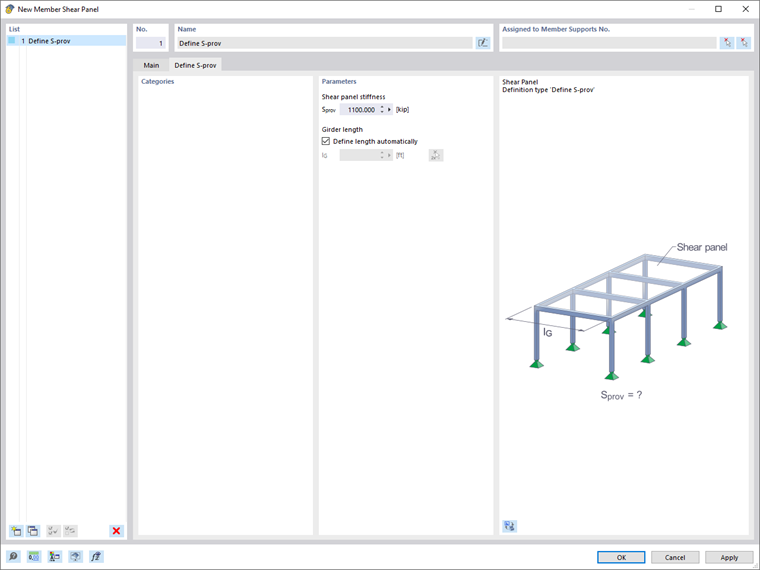To consider the fictitious stiffness from a member shear panel, you can assign it to a member support. This chapter describes the input options for a member shear panel.
Definition Type
Various types of shear panels are available for selection in the list:
- Sheeting Trapezoidal Sheeting
- Bracing
- sheeting_Bracing Trapezoidal Sheeting and Bracing
- Defining S-prov
Trapezoidal Sheeting
The following information is required to determine the shear panel stiffness of trapezoidal sheeting:
- Trapezoidal sheeting name
- Fastening arrangement
- Shear panel length
- Beam length
- Beam spacing
You can select the trapezoidal sheeting from the library using the
![]() button (see the image Cross-Section Library – Trapezoidal Sheeting). After selecting the trapezoidal sheeting, the shear panel coefficients K1 and K2 are automatically transferred according to the approval. However, these can also be changed, if necessary.
button (see the image Cross-Section Library – Trapezoidal Sheeting). After selecting the trapezoidal sheeting, the shear panel coefficients K1 and K2 are automatically transferred according to the approval. However, these can also be changed, if necessary.
The fastening arrangement for the trapezoidal section affects the shear stiffness that the sheeting provides to the beam. If the trapezoidal sheeting is fastened only in every second rib, the shear stiffness to be applied is reduced by the factor 5.
You can enter the shear panel length and the beam spacing manually. As an alternative, you can also define this graphically by selecting the "Measure" function using the
![]() button. Finally, you can select two snap points in the work window to adopt the distance between them.
button. Finally, you can select two snap points in the work window to adopt the distance between them.
The beam length is automatically adopted from the member or member set. Deactivate the "Define length automatically" check box if you want to specify the beam length manually.
Bracing
The following information is required to determine the shear panel stiffness of a bracing:
- Material name
- Diagonals – cross-section name
- Posts – cross-section name
- Shear panel length
- Beam length
- Beam spacing
- Post distance
- Number of bracing
You can select the material from the library by clicking the
![]() button (see the image Material Library). The modulus of elasticity is automatically taken from the selected material. However, you can also define it manually.
button (see the image Material Library). The modulus of elasticity is automatically taken from the selected material. However, you can also define it manually.
The easiest way to define the cross-sectional areas of the diagonals and posts is to select the respective cross-sections from the library using the
![]() button. The cross-sectional area is automatically adopted. You can also enter this value directly.
button. The cross-sectional area is automatically adopted. You can also enter this value directly.
You can enter the shear panel length as well as the beam and post spacing manually. As an alternative, you can also define this graphically by selecting the "Measure" function using the
![]() button. Finally, you can select two snap points in the work window to adopt the distance between them.
button. Finally, you can select two snap points in the work window to adopt the distance between them.
The beam length is automatically adopted from the member or member set. Deactivate the "Define length automatically" check box if you want to specify the beam length manually.
Furthermore, it is necessary to enter the number of bracing that stabilizes the roof level.
Trapezoidal Sheeting and Bracing
Use the "Trapezoidal Sheeting and Bracing" shear panel type to consider both trapezoidal sheeting and bracing as shear panels.
The following information is required to determine the shear panel stiffness:
- Material name
- Trapezoidal sheeting name
- Fastening arrangement
- Diagonals – cross-section name
- Posts – cross-section name
- Shear panel length
- Beam length
- Beam spacing
- Post distance
- Number of bracing
A description of the parameters can be found in the sections Sheeting Trapezoidal Sheeting and Bracing.
Defining S-prov
You can also specify the shear panel stiffness manually. The following information is required for this:
- Shear panel stiffness
- Beam length
The beam length is automatically adopted from the member or member set. Deactivate the "Define length automatically" check box if you want to specify the beam length manually.

